Neon Genesis Evangelion: The Complete Collection Review
Back in the day, the first anime I ever watched was Pokémon; the first manga I ever bought and read was the now sadly out-of-print sci-fi comedy Hyper Police; and the first anime I ever bought was Neon Genesis Evangelion.
Oh my god! Little did I know what I was letting myself in for. I cannot remember why I chose it. What I can tell you was that I originally got the ADV Films DVD release, and then quickly got around to buying their Platinum versions when they first came out. A Blu-ray release has long been coming, and finally All The Anime have done so, with another of their spectacular “Ultimate Editions”.
Right away, people were snapping them up. With an early bird price of £199.99, and a standard price of £299.99, the fact that people were willing to pay for this goes to show how much people love and respect Evangelion. The UK release sold out in 12 hours, meaning that another 1,000 copies had to be allocated. Sadly, I was one of the later ones meaning that my delivery won’t be coming until January, but I have been given a copy of the “Standard Edition” to review in the meantime.
If this is just “Standard”, then the “Ultimate” and the middle-range “Collector’s Editions” will be things you want to sink your teeth into. The “Standard” is by no means a bare-bones collection. Still on Blu-ray across five discs, containing the entire 26-part TV series and the two follow-up films, there are still lots of on-disc extras that come with this version, and we haven’t even started talking about the actual plot yet. Mind you, given how complicated Evangelion is, this may take some time.
Set in what was then the future when the series debuted in 1995, the background of the story sees the Earth having been devastated by an event called the “Second Impact” in 1999, when Antarctica was destroyed, leading to rising sea levels and a dramatic change in climate across the world. Fast forward to 2015, and teenager Shinji Ikari has moved to the city of Tokyo-3 on the orders of his father Gendoh (sometimes spelled “Gendo”, but in the subtitles of this release it has the “h” on the end). Gendoh is the director of NERV, an organisation devoted to slaying a race of gigantic monsters called “Angels”. The only things capable of stopping them are a form of mecha called “Evangelion”, or “EVA” for short, and the only people capable of controlling them are specially selected children such as Shinji, who is ordered to pilot EVA-01.
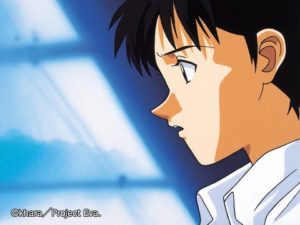
Justifiably, Shinji does not want anything to do with this, given that he and Gendoh are estranged, and thus he does not want to be dragged into his father’s business. He only agrees to it when he sees the injuries sustained by the pilot of the prototype EVA-00, Rei Ayanami. He does successfully slay the Angel, but he also sees what lies beneath the armour of the mecha: some kind of twisted beast that would make anyone terrified.
Objections from Shinji to continue fighting against the Angels are overruled, with him ending up training as a EVA pilot, while also doing his normal school studies in Tokyo-3, a city based in an underground “Geo-Front” where skyscrapers are drawn into the ground during battles to protect lives.
His estrangement means that rather than living with his father, Shinji stays with NERV officer Misato Katsuragi, a woman who, when she is on the job is competent and skilled and somewhat glamorous on the surface, but in private is an untidy alcoholic slob whose fridge contains almost nothing except beer, which she drinks first thing in the morning.
Nevertheless, Shinji continues his training, and while at school he begins to make some friends, such as Kensuke Aida who has a love of all things military, and tough-guy Tohji Suzuhara, who at first abuses Shinji because of all the damage he caused during his first battle which harmed his sister, but who eventually comes to respect the young pilot.
Soon others join the NERV cause. An overseas trip sees the arrival of the third pilot, the brash German-Japanese girl Asuka Langley Soryu who is constantly rude to Shinji, and Ryoji Kaji, a mysterious agent who clearly has had a relationship with Misato in the past, with her not being keen on him.
On the surface the series feels like a simple “monster-of-the-week” battle anime, but digging deeper, you come to learn of all kinds of underhand schemes going on. As the series progresses, Shinji and Asuka become haunted by their pasts, while the mysterious Rei has a twisted and haunting relationship with Gendoh.
NERV’s objectives seem to be preventing a “Third Impact” that would wipe out humanity, but is this the case? Are there people actually trying to bring it about? What was the actual cause of the Second Impact? Can everyone, even the head of NERV himself, be trusted? All of this intrigue is mixed in with elements of haunting psychological damage and religious elements that make Evangelion one of the most remarkable shows not just in anime, but in all television.
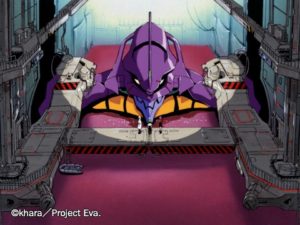
Immensely influential then and now, the impact that Evangelion has had on anime ever since it first came onto the scene is undeniable. What initially seems to be just a thrilling mecha-fighting show dives deep into the subconscious, as so many of the characters, especially the lead, go through their own share of troubles. All of the EVA pilots have lost a parent; Misato lost her father during the Second Impact; while NERV’s chief scientist, Ritsuko Akagi, has had to overcome the suicide of her mother, who created NERV’s supercomputer system. Near the end of the story we meet another EVA pilot, Kaworu Nagisa, whose role in the story is difficult to mention without giving away spoilers, but whose relationship with Shinji is one of the key elements to what makes the lead who he is.
Shinji is the person who has had to overcome the most. Not only with his mother dying when he was young, but Gendoh becoming ever more distant as he grows up, and clearly showing more affection for Rei than his own son. It’s not that surprising that he doesn’t want to fight, which for some viewers is annoying because that is what they want to see. No wonder there are so many memes about ordering Shinji to: “Get in the f***ing robot!” Yes, never mind the fact he is clearly disturbed, all we want the boy to do is kill, kill, kill (apparently).

Such things obviously trivialise matters. Today you can argue that many of the characters have such poor mental health that clearly what NERV really needed to spend their money on was a decent counsellor. If Shinji was just able to talk about his problems, things might have worked out better for him, the poor kid.
This psychological aspect however becomes even more engrossing when you combine it with another key element of Evangelion: the animation. Director and writer Hideaki Anno uses many different techniques across both the TV series and the films to pull the viewer in. As well as the standard animation, there are pencil drawings, felt-tip art, a heavy use of montages, and even live-action footage is used in the second of the two films.
It all mixes together to make Evangelion so unique. The trippy colours add to the sci-fi feel, while the psychological elements add a sense of unease. The whole thing has the aesthetic look of films such as 2001: A Space Odyssey (there are even black monoliths in the show), while at the same time the writing makes it feel at times more like a David Lynch film. Then there is the music.
Listening to Evangelion’s score is another key element to what makes it stand out. The biggest component of all of course is the opening theme tune. “A Cruel Angel’s Thesis”, as performed by Yoko Takahashi, is widely considered by many to be the greatest anime theme song of all time, even a quarter of a century after it debuted. Personally, I think part of the reason is the introduction, beginning as it does with a haunting, almost angelic chord, and then suddenly going all funk on us. Sadly, all of these new collections do not contain the original ending song, Claire Littley’s version of “Fly Me to the Moon” due to licensing issues. Instead a piece of instrumental piano music is used over the end credits.
Losing that track will be bad news for some, but there is still plenty of other music in the show entertain. There is the music used when Shinji and Asuka have to fight an Angel which requires them to be in perfect synch with each other, which also adds some comedy to the mix, while the series and films also use classical music throughout to great effect. Handel’s “Halleujah Chorus”, Beethoven’s “Ode to Joy”, Bach’s “Air on the G String” and Pachelbel’s “Canon” all feature in Evangelion.
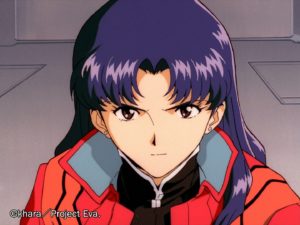
As I just mentioned, comedy does also play a role in the series, despite Evangelion’s focus mainly being on psychological drama. The humour is mainly slapstick, much of which comes from the show’s mascot character, Pen-Pen the Penguin, who is Misato’s pet. Perhaps the best gag is one in which Shinji, about to wash, storms into Misato’s kitchen naked, with only Misato’s can of beer in the foreground covering his modesty. When Misato picks up the can to drink, an even smaller can is revealed, still covering the important parts.
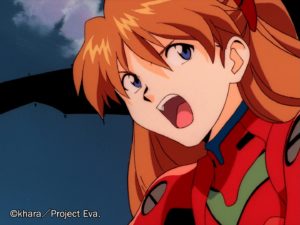
For all of this praise (the TV series has a 100% rating on Rotten Tomatoes), it has to be said that part of the reason why Evangelion is so well remembered and has lasted for so long is that the series is actually imperfect. Today, you may feel that there is a call for a revisionist look regarding how often the teenaged characters, especially Rei, are naked. Plus, the fact that there are so many different layers to the series, including the battles, the psychology, and the obscure religious references to things like the contents of the Dead Sea Scrolls make the series infuriatingly complicated to fully understand. Then there is the issue of the original ending of the TV series; an ending so perplexing and unsatisfactory that the studio, Gainax, was attacked by angry viewers.
Ultimately this lead to the creation of the two films that also form part of this Blu-ray collection. The first, Death (True)2, a re-edit of Death & Rebirth, is a primarily a compilation film. This finally led to The End of Evangelion, a retelling of the last two episodes which created a more dramatic, shocking, violent, and a more positively received ending to the series.
Concluding the series was a tough job and one that the creators of the series obviously felt was still not good enough, as was evidenced in 2007, when we witnessed the Rebuild tetralogy, a series of four films retelling the entire story of Evangelion from the very beginning. It was a venture that would ultimately take thirteen-and-a-half years to tell.
Knowing all this, trying to sum up all of Evangelion feels like an almost impossible task. You have the original TV series, then the first two films which retell the story, then a further four films which retell it again, and then all the various elements that one can investigate. You can study how Evangelion deals with mental health, or give a detailed examination of how all the various religious elements play their role in the story. Just recently, a 400-page book from Stockholm University Press entitled Anime Studies: Media-Specific Approaches to Neon Genesis Evangelion, released in English, has come out and has been made free-to-access online.
I personally look at it this way: no matter how you choose to read the show, Evangelion is a cornerstone in how anime has since been developed, told and produced. Every so often, a series comes along that lays its mark on the world. In the mid-to-late 1990s, Evangelion was that show. I can see influences appear in so many of the subsequent shows that I love. My favourite anime, Gurren Lagann, was also made by Gainax, and you can clearly see connections between the two stories. For example, both show characters at points trapped in a dream-world scenario seemingly offering them a perfect existence from which our heroes need to escape. Whether you want to dive into the psychology, the religion, or just enjoy the battles, it has a little bit of something for everyone. Given that this was the first anime I ever bought with my own money, it’s no wonder I became an anime critic.
Now that we have our hands on these Blu-ray collections, let us examine what is on them. Before we do, however, it should be mentioned that at times the animation quality varies. Due to a loss of some of the original 16mm negatives, the image quality is at brief moments less clear, such as the preview for Episode 19, but other than that, the collection seems technically sound. In the “Standard Edition” there is plenty to see; music videos, trailers, an Animatic collection, videos of voiceover auditions, image boards and deleted scenes are among the extra content on offer.
Going into the audio side of things, the “Standard Edition” for me is lacking one key area which is the dub. While the other versions come with two English dubs – the “Classic” that was used for the ADV release of the TV series and the Manga Entertainment release for the films; and a more modern VSI Los Angeles dub performed for Netflix – in the “Standard”, only the latter of these is available. This is a shame for me personally, because despite the fact I have a general dislike of dubs, partly due to an element of nostalgia the “Classic” dub is one that I still hark back to and treasure.
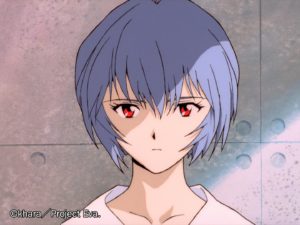
“Collector’s Edition” boxsets do come with both dubs. Because of this, the collection contains 11 discs as opposed to the five in the “Standard”, the 11th disc containing a special “Video Format Version” of The End of Evangelion. It also comes with eight art cards, a 40-page booklet, with everything containrf in a rigid box with three Amaray cases to house all the discs.
“Ultimate Edition” collections meanwhile come in a special, “premium-quality rigid-board shoulder box” with artwork that was used on Japan’s LaserDisc release of the series. Rather than just a 40-page booklet, the “Ultimate” has a 156-page book full of artwork, glossaries, timelines, and more. There are also art boards, a paperweight, a double-sided NERV ID card and a lanyard. No wonder it was so expensive.
Neon Genesis Evangelion is very definitely a must-watch series. I don’t mean just anime, I mean TV in general. If you are not an anime fan, this series is unlike anything you have ever experienced. It will freak you out with its mixture of plot, art, music and themes. There are landmarks in every artistic movement, and this is one in the world of anime.
To put it simply, if it was not for Evangelion, I would not be here, working for this website right now, and getting to express my love of anime and manga of all kinds to people who have to experience it yet. This series might not be for everyone, but it is essential viewing.


